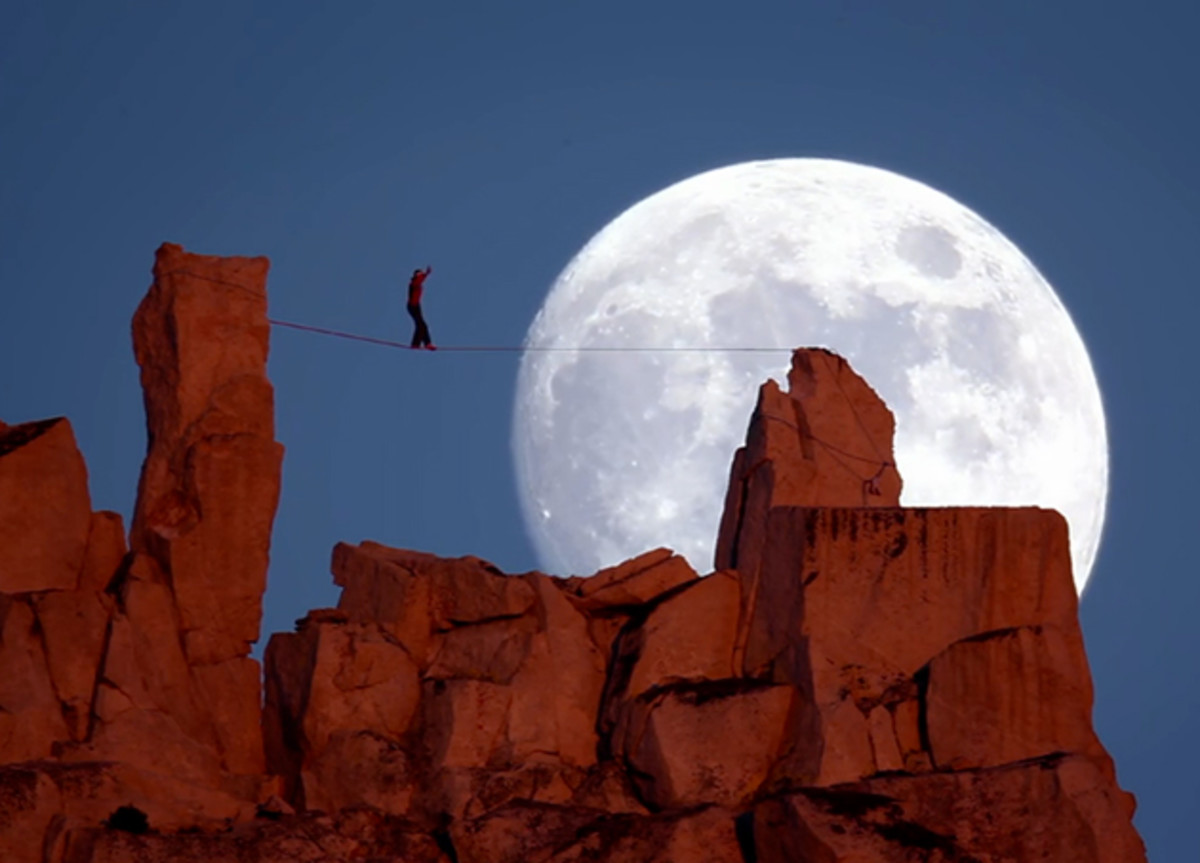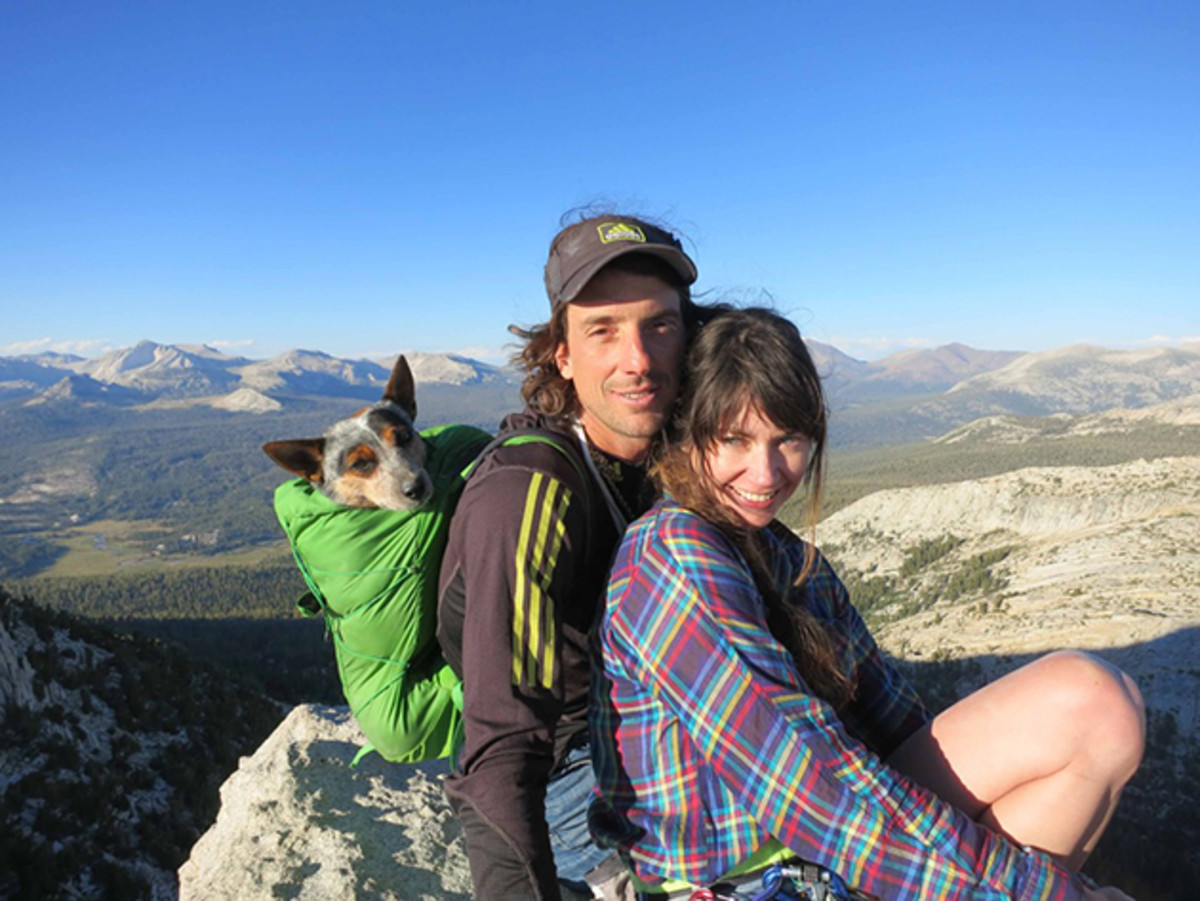Life on the Edge: Dean Potter Opens Up About His Daredevil Secrets

At a quiet spot along the outer loop of Hidden Valley Campground, nestled deep in Joshua Tree National Park in southeastern California, 20-year-old Dean Potter stood staring at a flexible piece of nylon wire, pulled taut a few feet off the ground between a rock and an old blue Chevy truck parked 40 feet away. The truck belonged to a homeless man named Charles (Chongo) Tucker, and so did the wire, as Potter found the stocky older man perched atop the line like a tightrope walker.
That was 22 years ago, when Potter first discovered slacklining—and walked the entire line in his very first attempt.
Today, Potter is an expert in a number of extreme disciplines: highlining, wingsuit flying, and speed and free solo rock climbing. He has walked on a one-inch slackline suspended thousands of feet above the ground across China’s Enshi Grand Canyon.
He has climbed summits using his bare hands and feet, relying on ropes only for protection. He has leapt off mountains wearing a wingsuit, plunging and swooping for miles with rocks looming beneath him. And he has even strapped his dog, Whisper, to his back to take the flight with him.
But even as Potter makes these breathtaking stunts appear easy, the daredevil admits he isn’t fearless. Potter shared his secrets with Edge, dishing on his special diet and workout routines, why he’s studying aerospace technology and what really happens right before he jumps.

On fear and being uncomfortable
As an alpinist, Potter has traversed numerous cliffs and peaks without the use of harnesses or safety gear—a skill he honed as a kid, climbing a 1,275-foot cliff on an Air Force base near his home in New Boston, N.H. But his interest in BASE-jumping (the acronym stands for the four categories from which one can jump: building, antenna, span and earth) came directly from his worst fear while climbing.
For Action Photographer/Filmmaker Jimmy Chin, New Challenges Lead to New Heights of Creativity
“I would see BASE jumpers playing in the same area that for me meant death,” says Potter about the vast air space surrounding the edge of a cliff. “It was the idea of combining climbing with parachuting and flying, and from then on I wanted to be as comfortable in the air as I was on the rocks.”
Now, Potter says he has become more at ease with jumping instead of climbing, but reveals that he is a lot more nervous and analytical than people expect. Potter constantly checks his gear when he is up on the rocks, always looking for small errors or faults and examining the disposition of the people around him.
“I’m more proud of how many times I haven’t jumped, than how many times I have jumped,” he says, crediting his keen intuition. “Sometimes walking down, I’ve saved my life.”
On avian aerodynamics and aerospace technology
Years ago, Potter visited one of the leading bird specialists in the country. He learned about gliding, wing shape and wind tunnels through photos and videos of birds in the wild, and applied the science to developing his wingsuits. Today, Potter is working with NASA scientists and aerospace specialists to design new wings.
“Since late January we have been working in the lab and now we have finished our first suit,” he says. “It’s one-of-a-kind and I’ll be testing it for its first flight.”
His search for a safer, more efficient wing suit is the result of the large number of deaths in the sport, many of whom were Potter’s partners or friends. His research is focused on decreasing the amount of human error that occurs during a flight and correcting the gear imperfections that cause malfunctions.
“I’ve never had a serious injury,” says Potter. “And I’ve never been on the scene for a fatality, so I started to look at what I do and what’s killing others.”
On his fitness regimen and detox diet
Potter gains most of his strength from simply practicing his craft: rock climbing uses almost every muscle in his body, he says. But he also runs ultra marathons, an extreme combination of distance running and climbing intermittently for 24 to 30 hours straight. When he’s not pushing the limits on all-day runs, Potter also stays in shape by running and walking with Whisper. And because he travels frequently, he practices yoga and performs body weight exercises, like push-ups, squats, sit-ups, back arches and pull-ups.
“My mom was a yoga teacher back in the 1960s, so I observed a lot of the practice,” he says. “It’s movement of the body with awareness to the breath, which you can do with running, push-ups or walking on a piece of nylon tied between two trees.”
Potter’s eating habits may be a bit more difficult for the average person to integrate into daily life. Most recently, Potter completed a three-week ayurvedic cleanse, during which he only ate mung beans (like lentils), rice and simple vegetables seasoned with cumin, turmeric and other spices that are known to detoxify the body. “I only ate until I was about 75 percent full,” he said of his ancient Indian approach. And in three weeks, the 6’5’’ and 200-pound adventurer lost 15 pounds. He has cut out all caffeine and white sugar, and limits his intake of both wheat and dairy.

On his dreams of being a professional basketball player
“With my height in high school, I was really thinking basketball,” Potter says. “But I guess I wasn’t that good, because my sophomore year I didn’t make the team. That was a really brutal moment for me.”
Instead, Potter ditched team sports and discovered long endurance runs. He became a high school track star, competing in high jump, pole vault, long jump and the mile run. After graduation, on the first day of freshman orientation at the University of New Hampshire, the rowing coach noticed Potter’s strong athletic build. Potter made the team and trained obsessively, sometimes twice a day, and quickly moved up the rankings. Potter didn’t climb at all, until his friend Charlie Bentley took him to Pawtuckaway State Park, less than 20 miles away from UNH.
“We climbed all day and I realized the whole time I was never trying to beat him, I was rooting for him,” says Potter. “Rowing was so competitive— the next day I dropped out of school.”
And a professional daredevil took off.
